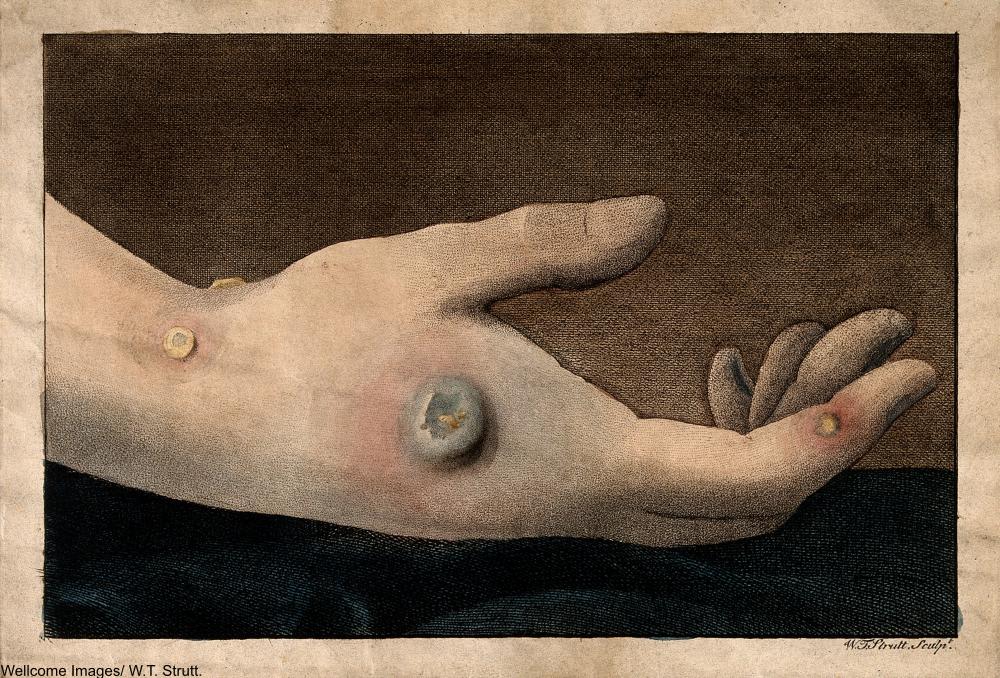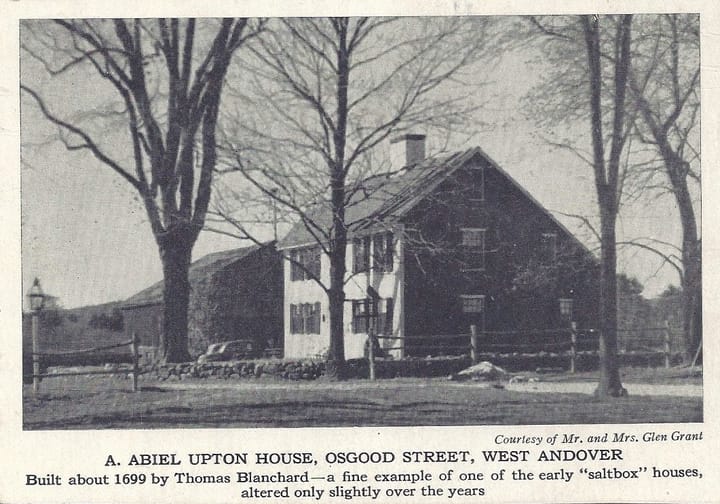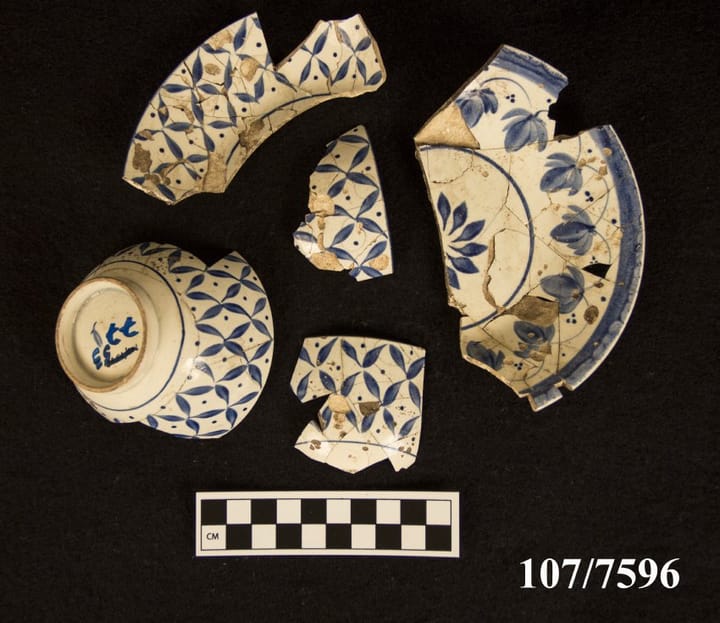Smallpox and the Salem Witch Trials come to the Horseshoe Tavern

When we left William Chandler and the Horseshoe Tavern in 1689, he had just renewed the license for his tavern and found himself at the center of the first murder in town, unknowingly serving the murderer, which led to the re-establishment of the town curfew. Unfortunately, things did not improve the following year, as his fellow citizens filed a complaint to close the Horseshoe in Court, and a smallpox outbreak added to the troubles. William was ready to leave Andover's Old Center behind.
The Horseshoe moves to South Parish
In 1690, William owned numerous holdings in Andover's South Parish and had already started giving land to his children. While we don't have precise information on when the Chandlers moved the Horseshoe to South Parish, many of their relatives had already settled there - Thomas moved in 1668, George and Hannah (Chandler) Abbott in 1676, and William's children occupied different portions of his land in South Parish. It was only natural for William and Bridget to join them. They decided to build a new home and open the Horseshoe along the busy Way to Boston, which was about 5-1/2 miles away from their old home/tavern. This distance meant it would take over 1-2 hours to walk (as most people still walked), and at least 30 minutes by horse or carriage.
With the move, William ensured he was far from the previous location's troubles. The new location allowed him to be closer to family and, at the same time, have a fresh start for the Horseshoe Tavern. But trouble soon followed the Chandlers.
Smallpox in Andover
In 1690, something significant happened in Andover – a smallpox outbreak, something the town had managed to avoid until then. Unlike Boston, which had experienced several outbreaks of smallpox in the 17th century, Andover had remained unaffected until now.

During that autumn, Martha (Allen) and her husband Carrier moved to Andover to live with her family, the Allens, along the Way to Boston. Interestingly, this new home was located right across the road from the Horseshoe tavern's new location. Before coming to Andover, the Carriers lived in Billerica, a neighboring town and a place known for smallpox. Unfortunately, in November of that year, Andover witnessed its first smallpox death, followed by eight more deaths over the next few months into 1691. Sadly, Martha was blamed by everyone for bringing smallpox to Andover.
The Allens were of Scottish origin, which meant they were likely patrons of the Horseshoe tavern. A few years back, Allen even negotiated a marriage contract within the tavern. But their connection with the tavern goes beyond just being patrons. Martha Carrier's mother, Faith (Ingalls) Allen, was the sister of Reverend Francis Dane's (William's stepbrother) first wife, Elizabeth Ingalls. Once again, family ties linked these people together in the community.
Martha Carrier was well-known to the Chandlers, as the Carrier's home was located less than half a mile from the Horseshoe tavern. Given the significant impact of smallpox on the Horseshoe's business, which likely led to its shutdown, we can only assume that the Chandlers faced challenging times during this period. Did they blame Martha Carrier as others did? What was the gossip like inside the Horseshoe? We can only guess it was not kind to Martha.
Andover Witches
The Horseshoe Tavern was bustling with gossip that affected everyone who visited, including the curious ears of children. Just one year after the smallpox epidemic, Andover found itself entangled in the infamous Salem witch hunt and trials. While I won't delve into the details of the Salem Witch trials, it's worth noting that Andover, including its taverns, was caught up in the witch hysteria. Shockingly, more than 60% of the accused individuals hailed from Andover, and each of them had to face trial in Salem. In a town with a population of about six hundred, this accounted for approximately 8% of its residents. Strangely enough, three taverns – Osgood's, Parker's, and the Horseshoe Tavern – were directly connected to either the accusers or the accused. It appears that taverns can sometimes attract trouble.
It could be argued that the Horseshoe Tavern was at the heart of it all. William Chandler's eleven-year-old daughter, Phebe, born on September 17, 1680, was one of the girls who fell ill and accused their neighbor, Martha Carrier, of being a witch. Phebe testified on August 2, 1692, stating, "My mother sent me to carry some beer to the folks who were at work in the lot, and when I came within Carrier's fence, there was a noise in the bushes which I thought was Martha Carrier's voice (which I knew well), but I saw nobody. The voice asked me what I did there and where I was going, which greatly frightened me."

In her further testimony, Phebe mentioned, "About a fortnight before Martha Carrier's apprehension, on the Lord's Day while the psalm was singing in the Church, she took me by the shoulder and asked where I lived. I didn't answer, even though Carrier, who lived next door to my father's house, surely knew who I was. Afterward, as I crossed the field several times, I heard a voice that I believed to be Martha Carrier's, and it seemed as if it were over my head. The voice told me that I would be poisoned within two or three days. And strangely enough, within such a short time, the right half of my hand became greatly swollen and very painful, along with a part of my face. I have no explanation for how this happened. It persisted for several days, and I have also experienced great pain in my breast and difficulties with my legs, making it hard for me to walk."
Phebe made a surprising claim that she had been struck deaf by "Martha Carrier's voice and temporarily crippled by her glance." It's quite astonishing to think that such a young girl, not even 12 years old, was now a key witness in the trial of Martha Carrier. Phebe was working for the Horseshoe Tavern, delivering beer to the fields, which must have given her some exposure to the discussions about Martha in the tavern, especially given the anger that followed the smallpox epidemic.
During the trial, Phebe was accompanied by her mother, Bridget Chandler, who supported her daughter's claims. Both of them knew Martha well, which adds to the significance of their testimony. Phebe's involvement in the Horseshoe Tavern and her proximity to the discussions about Martha could have played a role in her perception of events.
Interestingly, another family member, Benjamin Abbott, who was William's nephew from his sister Hannah and George Abbott, also accused Martha Carrier. Benjamin Abbott testified that around twelve months prior, Martha Carrier had been very angry with him when he was laying out some land near her husband's property. She expressed her anger by saying that she "would stick as close to Abbott as the bark sticks to a tree." Shortly after this incident, Abbott developed a swelling in his foot, and it became so severe that Dr. Prescot had to lance the sore, leading to several gallons of corruption draining out of it. Abbott's illness persisted until the day Martha Carrier was taken away, after which he gradually began to recover.
These testimonies reveal the intricate connections and complex emotions at play during the trials, where family ties and past events seemed to intertwine with the accusations against Martha Carrier.
Martha Carrier was a well-known figure in town, and her reputation was a topic of discussion in Andover. Some saw her as the one who brought smallpox to the town and a quarrelsome neighbor, while others, like her uncle Reverend Francis Dane, believed she was merely a "victim of malicious gossip." As taverns served as gathering places, it's highly likely that Phebe Chandler, being associated with the Horseshoe Tavern, heard various stories about Martha as townsmen gathered and chatted.
The situation escalated, and by the end of May 1692, Martha Carrier, along with Samuel Wardwell and Mary Ayer Parker (widow of another Innholder), both from Andover, were locked up and later hanged for being accused of witches on August 19, 1692. In Mary Parker's case, she was said to have suffered from a "distempered mind," and after her execution, her sons faced the unfortunate situation of having their property seized. Told she left no estate, the officer seized their cattle, corn, and hay. However, they were able to claim some restitution of eight pounds.
Other family members were accused of being a witch. Two of Rev. Francis Dane's daughters, Abigail Dane Faulkner and Elizabeth Dane Johnson, were convicted and condemned to hang. Numerous of Dane's grandchildren were imprisoned. Elizabeth Johnson, Junior (subject of the North Andover students' recent successful campaign for her exoneration) was also targeted for execution.
Interestingly, this time the accusation came from another tavern. On September 8, 1692, Mary Osgood, wife of Captain Osgood (an Inn/Tavern owner and leader of the petition against the Horseshoe 3 years prior) confessed that for eleven years she had been devoted to the service of Satan.
The Chandler family was deeply involved in the Salem Witch Trials of 1692. Phebe Chandler (daughter), Bridget Chandler (wife), Thomas Chandler (brother), and Benjamin Abbot (nephew) all gave testimonies during the trials. On the other hand, brother-in-law Rev. Francis Dane's children and grandchildren and daughter-in-law Deliverance Dane faced accusations during this tumultuous period.
Andover Taverns involved in the Salem Witch Trials
What role did taverns play in the Witch Trials? While we may never know for sure, we can make some educated guesses considering the number of tavern owners and their relatives involved in the trials. It's intriguing to note that fourteen accused and six accusers were either tavern owners or related to them, making all three taverns – Horseshoe, Osgood's, and Parker's – directly involved in some capacity.
Taverns back in the late 1600s served as meeting places where neighbors gathered. Rum consumption was rampant during this time, with reports suggesting that the average person drank over five glasses per day. The earlier petitions indicated that taverns were filled with lots of alcohol, rowdy behavior, late-night gatherings well past curfew, games, and numerous toasts. Alcoholism and unruly conduct were problems of concern. Even though women, children, and servants (negros/African Americans) were not allowed to enter taverns, we have testimonies of young Phebe Chandler, just eleven years old, delivering beer to customers at the Horseshoe Tavern.
The 1690 smallpox outbreak and the associated isolation likely contributed to additional tensions and bad behavior, leading to finger-pointing and accusations. As we've seen during the recent COVID epidemic, lack of socialization can create psychological strain, giving rise to conversations and conflicts we could not have imagined before. Martha Carrier, who was blamed for bringing smallpox to town, found herself at the center of the turmoil, especially considering that her sister, Mary Toothaker, had already been accused in Salem, increasing the likelihood of suspicions against her. Chandler's Horseshoe Tavern was conveniently located directly across the road from Martha's home, and another accuser, nephew Benjamin Abbot, lived just 2.5 miles away. It's reasonable to assume that conversations in a tavern, especially after a few drinks, might have turned heated and contentious. In total, 45 citizens from Andover were accused, with each tavern playing a part in this tumultuous time.
The Salem Witch Trials were undoubtedly a dark chapter in the history of the Chandler family, as they were both witnesses and accused parties, caught up in the turmoil of that time. Stepbrother and brother-in-law, Rev. Francis Dane, campaigned tirelessly through petitions to court and governor to end the Witch Hunt. In support of the accused, William, Bridget, and Thomas Chandler later signed a petition. However, their nephew Benjamin Abbot never signed the petition, revealing the complexity of family dynamics during these challenging times.
Sources:
Bailey, Sarah Loring, Historical Sketches of Andover, Houghton, Mifflin and Company, Boston 1880.
Chandler, George, William and Annis Chandler 1637, Ancestry.com - The Chandler family : the descendants of William and Annis Chandler who settled in Roxbury, Mass., 1637 1883.
Hanes-Mofford, Julie, Andover, Massachusetts: Historical Selections From Four Centuries, Merrimack Valley Preservation Press, 2004.
Roach, Marilynne, Six Women of Salem: The untold Story of the Accused and their Accusers in the Salem Witch Trials, Da Capo Press, 2013.
Schiff, Stacy, The Witches: Suspicion, Betrayal, and Hysteria in 1692 Salem, Little, Brown and Company, New York, 2015.
Recommended reading
Kent, Kathleen, Heretic's Daughter, Little, Brown and Company, New York, 2008. This fictional book is based on the life of Martha Carrier through the eyes of her daughter, Sarah. It is a griping tale based on historical facts.



Comments ()